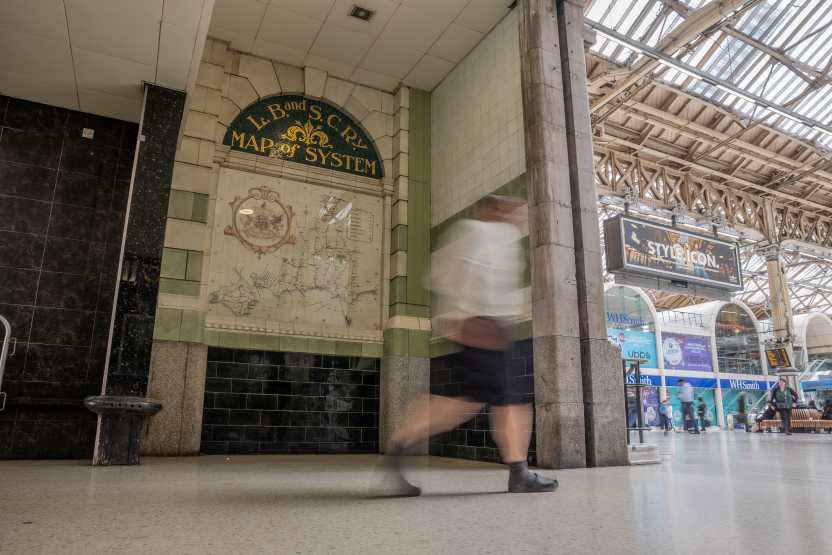Tuesday, May 13, 2025

Historic ceramic rail maps that date back to the late Victorian era have been meticulously restored at London’s iconic Grade II listed Victoria Station. Hidden for decades behind layers of modern alterations, these ornate hand-painted maps have been carefully refurbished, securing their preservation for generations to come. This ambitious restoration project was managed by Govia Thameslink Railway (GTR), supported by funding from Network Rail and the Railway Heritage Trust.
The maps, originally created in 1899, were part of an elaborate, faience-clad entrance designed in Renaissance revival style for the London Brighton & South Coast Railway (LB&SCR). Their rediscovery and subsequent restoration mark a significant contribution to preserving Britain’s historic railway infrastructure, coinciding with the national celebration marking 200 years since the birth of the modern railway.
Discovering Hidden Heritage
The ornate ceramic rail maps at Victoria Station had remained hidden behind various structures, from early telephone booths to a newsstand installed mid-20th century. Uncovered years ago, the maps were found significantly damaged, with their detailed architectural surroundings showing clear signs of neglect.
The restoration process began with a thorough assessment by specialists from Restore London, a conservation firm renowned for meticulous heritage work. These experts cleaned the maps carefully, uncovering intricate detailing that had remained obscured for decades. Broken tiles and damaged stonework surrounding the maps were expertly restored by the historic tile maker Craven Dunnill Jackfield, established in 1872 and recognized for their heritage tile craftsmanship.
Architectural Significance and History
The maps were originally commissioned during an ambitious redevelopment of Victoria Station, led by Sir Charles Langbridge Morgan, the railway’s chief engineer, and architect C.D. Collins. Designed as part of the elegant entrance to the station, the ceramic maps showcased the extensive rail network of the LB&SCR, highlighting suburban and regional lines, many of which no longer exist.
Benedict O’Looney, GTR’s architect and a dedicated member of the Victorian Society, highlighted the architectural and historical significance of the restoration. According to O’Looney, around 1900, Victoria Station became a focal point of competition between major railway companies—the LB&SCR and the South Eastern Railway. Both companies invested significantly in high-quality, visually striking station fronts designed in the fashionable Beaux-Arts and Baroque revival styles of the period.
“These maps represent the height of Edwardian craftsmanship and architectural ceramics, showcasing robust, elegant, and soot-resistant designs crucial for the industrial era railway stations,” O’Looney explained.
Collaborative Effort and Heritage Funding
Govia Thameslink Railway’s Infrastructure Director Keith Jipps described the restoration as a prime example of effective collaboration among industry partners. The project received crucial financial backing from Network Rail, alongside a significant heritage grant from the Railway Heritage Trust, an independent charitable trust dedicated to conserving Britain’s rich railway heritage.
Tim Hedley-Jones, Executive Director of the Railway Heritage Trust, emphasized the historical value of the project. “We had long aspired to restore these ceramic maps since their discovery years ago,” he said. “When match funding became available through Network Rail, we were delighted to contribute grant support, enabling this important restoration to move forward.”
Lucy McAuliffe, Sussex Route Director at Network Rail, affirmed the organisation’s commitment to preserving railway heritage, expressing pride in Network Rail’s involvement. “Collaborating with GTR and the Railway Heritage Trust allowed us to preserve an integral part of our historical infrastructure, reminding future generations of the railway’s important role in the UK’s development,” McAuliffe said.
Preserving a Legacy for Future Generations
The restored maps now stand as a testament to Britain’s rich railway history, prominently located at the bustling Victoria Station, which continues to serve millions of passengers annually. The project’s completion has been celebrated with the installation of a distinctive blue heritage plaque, further highlighting the site’s historic significance.
According to Historic England, Victoria Station, a Grade II listed building, holds significant value as an exemplar of late Victorian architecture and engineering. The ceramic maps’ restoration enhances public appreciation of this historical context, providing commuters and tourists alike a direct connection to the era that shaped modern Britain.
The restoration aligns with broader government efforts to conserve and celebrate the UK’s heritage assets, as emphasized in policies by the Department for Culture, Media and Sport (DCMS). These guidelines stress the importance of conserving historical buildings and structures that contribute significantly to local and national heritage identity.
Educational and Cultural Impact
Beyond their aesthetic appeal, the maps serve as educational tools, informing current and future generations about historical railway routes, technological progress, and the cultural heritage embedded in Britain’s infrastructure.
This project has been documented extensively on official heritage portals, including Historic England, Railway Heritage Trust, and Network Rail websites, providing valuable educational resources about the importance of heritage conservation.
A Milestone in Railway Heritage
The restoration of the ceramic maps at Victoria Station is a critical milestone in ongoing preservation efforts across the UK’s railway network. It signifies a commitment to maintaining historical landmarks that offer insights into the country’s industrial past and architectural prowess.
Visitors to Victoria Station can now directly engage with a tangible piece of railway history, appreciating the craftsmanship and dedication involved in Victorian-era architectural practices. The ceramic maps, now vividly restored, continue to narrate stories from an era of ambitious railway expansion and artistic achievement.
This project represents the railway industry’s dedication to safeguarding Britain’s rich heritage, showcasing how cooperation among government agencies, heritage organizations, and industry stakeholders can effectively preserve important historical artefacts.
As the UK continues to celebrate the bicentenary of the modern railway’s inception, the restoration of Victoria Station’s ceramic maps exemplifies a broader recognition of railway heritage’s pivotal role in shaping modern Britain’s socio-economic landscape.
Through such dedicated efforts, invaluable pieces of history remain preserved, accessible, and appreciated by both the present-day public and future generations.






